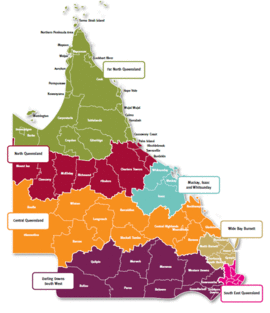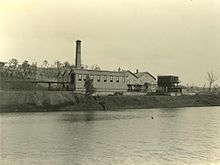Central Queensland
| Central Queensland Queensland | |
|---|---|
 The Regions of Queensland | |
| Coordinates | 23°26′S144°53′E/ 23.44°S 144.88°E |
| Population | 233,931 (2011 census)[1] |
| LGA(s) | |
| State electorate(s) | |
| Federal division(s) | Capricornia |
Central Queenslandis an imprecisely-definedgeographicaldivision ofQueensland(a state in Australia) that centres on the eastern coast, around theTropic of Capricorn.Its major regional centre isRockhampton.The region extends from theCapricorn Coastwest to the Central Highlands atEmerald,north to theMackay Regional Councilsouthern boundary, and south toGladstone.The region is also known asCapricornia.It is one of Australia's main coal exporting regions.
At the 2011 Australian Census the region recorded a total population from the six local government areas of 233,931.[1]
Industry[edit]

Economically, Central Queensland is an important centre ofprimary sectorindustries,particularly for food and fibre production.[2]Central Queensland includes theBowen Basinwhich is rich in high quality coking coal, thePort of Gladstoneproduces 40% of the state's export earnings, theFitzroy Riveris the second-largest river system in Australia and commands significant water resources such asFairbairn Dam.Gladstone has a significant aluminium smelter.
Beef[edit]
Rockhampton is claimed to be the beef capital of Australia, a title which is disputed byCasinoin New South Wales.[3]Beef production in the region is centred on Brigalow and speargrass land types.[4]Every three years, Rockhampton holds the nationalBeef Australiaexposition to celebrate the cattle industry as well as to facilitate trade opportunities for Australian beef producers.[5]
Mining[edit]

Central Queensland is one of the world's leading producers and exporters ofblack coal.[6]Ludwig Leichhardtwas the first European to discover coal deposits in the region in 1845.[7]In the 2011-2012 financial year the region produced 40% of the state's total coal production.[8]
Coal is extracted from theBowen Basinand transported to port facilities atPort of Gladstonevia theBlackwater railway systemor to bothHay PointandAbbot Pointvia theGoonyella railway line.Coal mining is expanding west into theGalilee Basinand requires an extension of the Goonyella line to transport coal to port. Many mines in the region, particularly those within theFitzroy Riverbasin, were severely impacted by flooding during the2010–11 Queensland floods.[9]
Gold, silver, limestone, coal seam gas, magnesite and gemstones are also mined.[6]Sapphires were discovered here in 1875.[10]Gold was discovered in the Mount Morgan region around 1865.Mount Morgan Minehas since gone on to become one of Australia's richest mines.[11]
Purpose-built mining towns in Central Queensland includeDysart,Middlemount,Moranbah,Mount MorganandMoura.Three mining disaster have occurred at Moura since 1975, resulting in the loss of 36 lives.[12]
Citrus canker outbreak[edit]
In 2004, anorchardon Evergreen farm was the site of the first detection ofcitrus cankerin Central Queensland. A significant part of the citrus growing industry was devastated when a total of 6,000 acres (24 km2) of crop had to be destroyed so the disease would not spread across the country.[13]In 2005 several freshoutbreakswere reported so the eradication expanded to include private backyard trees.[14]The outbreak's cause has not been fully explained despite a federal inquiry.[13]In 2009 authorities from theGovernment of Queenslanddeclared the eradication program complete.
Protected areas[edit]


The region contain 33 national parks.Great Keppel Islandhas been an island tourist attraction since the 1960s. It and several other islands in the area are surrounded by coral reefs.[15]In the west of the region is Queensland's central highlands and theCarnarvon Gorge,which is protected within theCarnarvon National Park.Carnarvon Gorge features white sandstone cliffs, steep-sided gorges a diverse range of significant plant and animal species and many walking tracks.[16]Kroombit Tops National Parkprovides habitat for the endemicKroombit tinker frog.Deepwater National Parkis good place for turtle watching. From November to March three species of turtle lay their eggs on beaches protected within the park.[17]
Communities[edit]
For this purpose the area of Central Queensland was restricted to the areas encircled by theDawson Highwaybetween Gladstone and Springsure; theGregory Highwaybetween Springsure and Clermont, and thePeak Downs Highwaybetween Clermont and enters North Queensland via Mackay – extended right to the eastern coastline.
Major cities in the region areEmerald,GladstoneandRockhampton.Some communities on theCapricorn CoastincludeByfield,Yeppoon,Great Keppel Island,Emu ParkandCawarral.
History[edit]
Gungabula(also known asKongabulaandKhungabula) is anAustralian Aboriginal languageof the headwaters of theDawson Riverin Central Queensland. The language region includes areas within the local government area ofMaranoa Region,particularly the towns ofCharleville,AugathellaandBlackalland as well as theCarnarvon Range.[18]
Wadja(also known asWadjigu,Wadya,Wadjainngo,Mandalgu,andWadjigun)is an Australian Aboriginal language in Central Queensland. The language region includes the local government areas of theAboriginal Shire of WoorabindaandCentral Highlands Region,including theBlackdown Tablelands.theComet River,and theExpedition Range,and the towns ofWoorabinda,SpringsureandRolleston.[19]
Yagalingu(also known asJagalingu,Auanbura,Kokleburra,Owanburra,Kowanburra,Wagalbara,andDjagalingu) is an Australian Aboriginal language of Central Queensland. Its traditional language region was within the local government area ofIsaac Region,from the headwaters of theBelyando Riversouth to Avoca, north toLaglan,west to theGreat Dividing Range,and east and south toDrummond Range.[20]
Yambina(also known asJambinaandJambeena) is anAustralian Aboriginal languageof Central Queensland. Its traditional language region is the local government area ofCentral Highlands Region,includingPeak Downs,Logan Creek, south to Avon Downs, east toDenham Rangeand Logan Downs, west to Elgin Downs and at Solferino.[21]
Yetimarala(also known asJetimarala,Yetimaralla,andBayali) is anAustralian Aboriginal languageof Central Queensland. Its traditional language region is within the local government areas ofCentral Highlands Region,on theBoomer RangeandBroadsound Rangeand theFitzroy River,Killarney Station,Mackenzie RiverandIsaac River.[22]
In 1889 Central Queenslanders in Rockhampton established theCentral Queensland Territorial Separation Leaguewith the hopes of turning Central Queensland into its own state. The core argument of secessionist movement was that the seat of government, Brisbane was in the south-east corner of the State. It was so far removed from substantial portions of the state that these areas and their citizens were left disadvantaged and neglected as political and economic interests focused on the south. Supplementing the Central Queensland Territorial Separation League, the women of Rockhampton established their own separation league in October 1892. Their main focus was preparing apetitiontoQueen Victoria.The introductory text set out their grievances and described the immense size of Queensland: being twelve times the area of England and Wales, and larger than France, Germany, Spain and Portugal combined.[23]
Education[edit]
Central Queensland Universityhas a campus at Emerald, Gladstone and Rockhampton.
Library Service[edit]
The Central Highlands Regional Council operates the following library branches:[24]
- EmeraldLibrary
- The Gemfieldslibrary
- BlackwaterLibrary
- DingoLibrary
- DuaringaLibrary
- CapellaLibrary
- TieriLibrary
- SpringsureLibrary
- RollestonLibrary
- BauhiniaLibrary
See also[edit]
References[edit]
- ^ab"Census data".2011 Census of Population and Housing.Australian Bureau of Statistics.Archivedfrom the original on 10 April 2009.Retrieved3 August2014.
- ^"An Overview of Food and Fibre Industries in Central Queensland"(PDF).Regional Development Australia.Retrieved20 June2014.[permanent dead link]
- ^Paul Robinson, Elloise Farrow-Smith & Miranda Saunders (17 April 2014)."An ownership row has erupted over who holds Australia's Beef Capital title".Australia: ABC News.Archivedfrom the original on 5 August 2017.Retrieved19 June2014.
- ^"The economics of beef in Central Queensland"(PDF).Department of Primary Industries and Fisheries.Archived(PDF)from the original on 4 February 2014.Retrieved20 June2014.
- ^About Beef AustraliaArchived10 December 2017 at theWayback Machine,Beef Australiawebsite. Accessed 10 December 2017.
- ^ab"Central Queensland information and maps".Department of Natural Resources and Mines.The State of Queensland. 27 February 2014. Archived fromthe originalon 4 July 2014.Retrieved19 June2014.
- ^"Coal Mining in Blackwater".Blackwater International Coal Centre. Archived fromthe originalon 29 July 2013.Retrieved3 August2014.
- ^"Central Queensland Regional Plan".Department of Infrastructure, Local Government and Planning. 24 April 2015. Archived fromthe originalon 7 May 2015.Retrieved26 April2015.
- ^"Return to full production for flood affected mines in Central Queensland".Queensland Reconstruction Authority.Queensland Government.Archivedfrom the original on 8 August 2014.Retrieved19 June2014.
- ^"History of the Sapphire Industry – Central Queensland".Australian Sapphire.Archivedfrom the original on 10 June 2014.Retrieved19 June2014.
- ^"Mount Morgan Mine Site (entry 600751)".Queensland Heritage Register.Queensland Heritage Council.Retrieved19 June2014.
- ^"Moura inquiries".The State of Queensland. Archived fromthe originalon 21 March 2014.Retrieved3 August2014.
- ^ab"Spot of Trouble".Landline.29 March 2009.
- ^"Citrus canker outbreak to impact on residents".Australia: ABC News. 7 September 2005.Retrieved29 March2008.[permanent dead link]
- ^"About Keppel Bay Islands".Department of National Parks, Recreation, Sport and Racing. 6 January 2014.Archivedfrom the original on 27 February 2014.Retrieved19 June2014.
- ^"About Carnarvon Gorge".Department of National Parks, Recreation, Sport and Racing. 20 October 2009.Archivedfrom the original on 24 July 2014.Retrieved19 June2014.
- ^"Nature, culture and history".Department of National Parks, Recreation, Sport and Racing. 19 October 2009.Archivedfrom the original on 2 September 2014.Retrieved19 June2014.
- ^
 This Wikipedia article incorporatesCC-BY-4.0licensedtext from:"Gungabula".Queensland Aboriginal and Torres Strait Islander languages map.State Library of Queensland.Retrieved28 January2020.
This Wikipedia article incorporatesCC-BY-4.0licensedtext from:"Gungabula".Queensland Aboriginal and Torres Strait Islander languages map.State Library of Queensland.Retrieved28 January2020.
- ^
 This Wikipedia article incorporatesCC-BY-4.0licensedtext from:"Wadja".Queensland Aboriginal and Torres Strait Islander languages map.State Library of Queensland.Retrieved5 February2020.
This Wikipedia article incorporatesCC-BY-4.0licensedtext from:"Wadja".Queensland Aboriginal and Torres Strait Islander languages map.State Library of Queensland.Retrieved5 February2020.
- ^
 This Wikipedia article incorporatesCC-BY-4.0licensedtext from:"Yagalingu".Queensland Aboriginal and Torres Strait Islander languages map.State Library of Queensland.Retrieved30 January2020.
This Wikipedia article incorporatesCC-BY-4.0licensedtext from:"Yagalingu".Queensland Aboriginal and Torres Strait Islander languages map.State Library of Queensland.Retrieved30 January2020.
- ^
 This Wikipedia article incorporatesCC-BY-4.0licensedtext from:"Yambina".Queensland Aboriginal and Torres Strait Islander languages map.State Library of Queensland.Retrieved30 January2020.
This Wikipedia article incorporatesCC-BY-4.0licensedtext from:"Yambina".Queensland Aboriginal and Torres Strait Islander languages map.State Library of Queensland.Retrieved30 January2020.
- ^
 This Wikipedia article incorporatesCC-BY-4.0licensedtext from:"Yetimarala".Queensland Aboriginal and Torres Strait Islander languages map.State Library of Queensland.Retrieved30 January2020.
This Wikipedia article incorporatesCC-BY-4.0licensedtext from:"Yetimarala".Queensland Aboriginal and Torres Strait Islander languages map.State Library of Queensland.Retrieved30 January2020.
- ^
 This Wikipedia article incorporatesCC-BY-4.0licensedtext from:"Central Queensland Separation League Petition 1892-1893: treasure collection of the John Oxley Library".State Library of Queensland.24 February 2021.Retrieved21 May2021.
This Wikipedia article incorporatesCC-BY-4.0licensedtext from:"Central Queensland Separation League Petition 1892-1893: treasure collection of the John Oxley Library".State Library of Queensland.24 February 2021.Retrieved21 May2021.
- ^"Central Highlands Regional Libraries Locations and Hours".Archivedfrom the original on 4 May 2017.Retrieved1 May2017.
External links[edit]
![]() Media related toCentral Queenslandat Wikimedia Commons
Media related toCentral Queenslandat Wikimedia Commons

